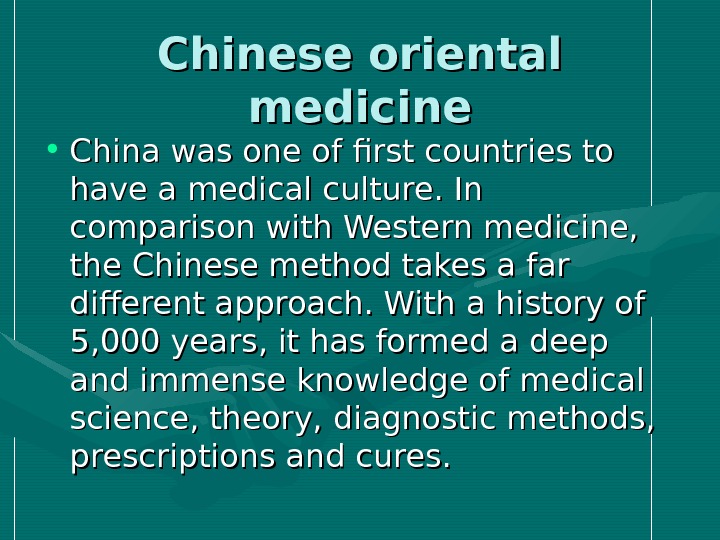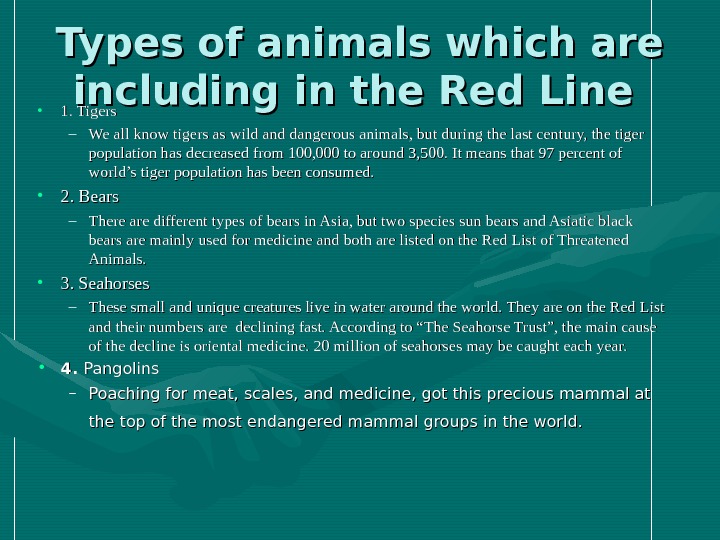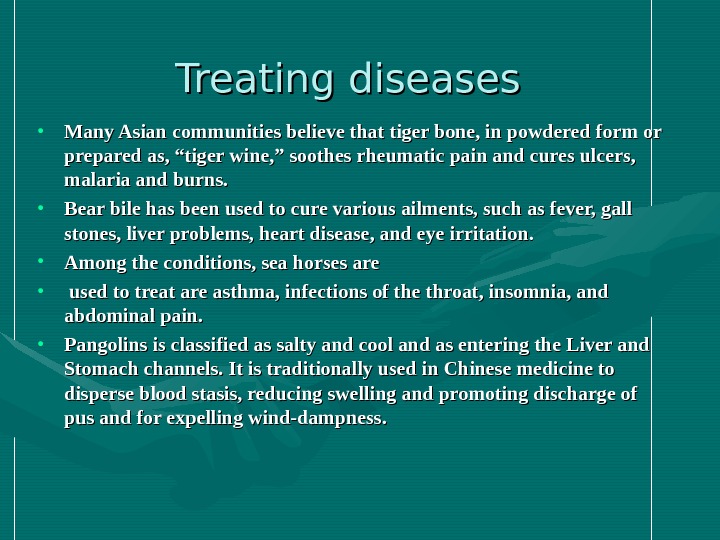Oriental medicine and loss biodiversity. Oriental medicine and













oriental_medicine_and_loss_biodiversity.ppt
- Размер: 738 Кб
- Количество слайдов: 12
Описание презентации Oriental medicine and loss biodiversity. Oriental medicine and по слайдам
 Oriental medicine and loss biodiversity Niyazov Zhanybek 20122077 Salamatbekov Almat 20120312 Gayetova Nargiza 20120445 TT rading to extinction
Oriental medicine and loss biodiversity Niyazov Zhanybek 20122077 Salamatbekov Almat 20120312 Gayetova Nargiza 20120445 TT rading to extinction
 • History – Chinese oriental medicine • Animals in oriental medicine – Types of animals – Treating diseases • Loss of Biodiversity – Consequences • Solution • Conclusion • References Outline
• History – Chinese oriental medicine • Animals in oriental medicine – Types of animals – Treating diseases • Loss of Biodiversity – Consequences • Solution • Conclusion • References Outline
 A Brief History of Oriental Medicine • Over the centuries there have been many individuals whocontributed to the founding and development of Chinese medicine. Legend has it that the first individual was Shennong, who is often referred to as the Father of Oriental Medicine. Another important individual was Huang Di, the Yellow Emperor. . He supposedly wrote the Nei Jing or Cannon of Medicine, also referred to as the Yellow Emperor’s Inner Classic.
A Brief History of Oriental Medicine • Over the centuries there have been many individuals whocontributed to the founding and development of Chinese medicine. Legend has it that the first individual was Shennong, who is often referred to as the Father of Oriental Medicine. Another important individual was Huang Di, the Yellow Emperor. . He supposedly wrote the Nei Jing or Cannon of Medicine, also referred to as the Yellow Emperor’s Inner Classic.
 Chinese oriental medicine • China was one of first countries to have a medical culture. In comparison with Western medicine, the Chinese method takes a far different approach. With a history of 5, 000 years, it has formed a deep and immense knowledge of medical science, theory, diagnostic methods, prescriptions and cures.
Chinese oriental medicine • China was one of first countries to have a medical culture. In comparison with Western medicine, the Chinese method takes a far different approach. With a history of 5, 000 years, it has formed a deep and immense knowledge of medical science, theory, diagnostic methods, prescriptions and cures.
 Animals in oriental medicine Traditional Chinese medicine uses about 1. 000 plant and 36 animal species, including the tiger, rhinoceros, black bear, musk deer, and sea horse; the tiger, rhinoceros are endangered.
Animals in oriental medicine Traditional Chinese medicine uses about 1. 000 plant and 36 animal species, including the tiger, rhinoceros, black bear, musk deer, and sea horse; the tiger, rhinoceros are endangered.
 Types of animals which are including in the Red Line • 1. Tigers – We all know tigers as wild and dangerous animals, but during the last century, the tiger population has decreased from 100, 000 to around 3, 500. It means that 97 percent of world’s tiger population has been consumed. • 2. Bears – There are different types of bears in Asia, but two species sun bears and Asiatic black bears are mainly used for medicine and both are listed on the Red List of Threatened Animals. • 3. Seahorses – These small and unique creatures live in water around the world. They are on the Red List and their numbers are declining fast. According to “The Seahorse Trust”, the main cause of the decline is oriental medicine. 20 million of seahorses may be caught each year. • 4. 4. Pangolins – Poaching for meat, scales, and medicine, got this precious mammal at the top of the most endangered mammal groups in the world.
Types of animals which are including in the Red Line • 1. Tigers – We all know tigers as wild and dangerous animals, but during the last century, the tiger population has decreased from 100, 000 to around 3, 500. It means that 97 percent of world’s tiger population has been consumed. • 2. Bears – There are different types of bears in Asia, but two species sun bears and Asiatic black bears are mainly used for medicine and both are listed on the Red List of Threatened Animals. • 3. Seahorses – These small and unique creatures live in water around the world. They are on the Red List and their numbers are declining fast. According to “The Seahorse Trust”, the main cause of the decline is oriental medicine. 20 million of seahorses may be caught each year. • 4. 4. Pangolins – Poaching for meat, scales, and medicine, got this precious mammal at the top of the most endangered mammal groups in the world.
 Treating diseases • Many Asian communities believe that tiger bone, in powdered form or prepared as, “tiger wine, ” soothes rheumatic pain and cures ulcers, malaria and burns. • Bear bile has been used to cure various ailments, such as fever, gall stones, liver problems, heart disease, and eye irritation. • Among the conditions, sea horses are • used to treat are asthma, infections of the throat, insomnia, and abdominal pain. • Pangolins is classified as salty and cool and as entering the Liver and Stomach channels. It is traditionally used in Chinese medicine to disperse blood stasis, reducing swelling and promoting discharge of pus and for expelling wind-dampness.
Treating diseases • Many Asian communities believe that tiger bone, in powdered form or prepared as, “tiger wine, ” soothes rheumatic pain and cures ulcers, malaria and burns. • Bear bile has been used to cure various ailments, such as fever, gall stones, liver problems, heart disease, and eye irritation. • Among the conditions, sea horses are • used to treat are asthma, infections of the throat, insomnia, and abdominal pain. • Pangolins is classified as salty and cool and as entering the Liver and Stomach channels. It is traditionally used in Chinese medicine to disperse blood stasis, reducing swelling and promoting discharge of pus and for expelling wind-dampness.
 Loss of Biodiversity • The world environmental situation is likely to be further aggravated by the increasingly rapid, large scale global extinction of species. It occurred in the 20 th century at a rate that was a thousand times higher than the average rate during the preceding 65 million years. This is likely to destabilize various ecosystems including agricultural systems.
Loss of Biodiversity • The world environmental situation is likely to be further aggravated by the increasingly rapid, large scale global extinction of species. It occurred in the 20 th century at a rate that was a thousand times higher than the average rate during the preceding 65 million years. This is likely to destabilize various ecosystems including agricultural systems.
 Consequences of Loss of Biodiversity • Habitat loss and degradation • Climate change • Excessive nutrient load and other forms of pollution • Over-exploitation and unsustainable use • Invasive alien species
Consequences of Loss of Biodiversity • Habitat loss and degradation • Climate change • Excessive nutrient load and other forms of pollution • Over-exploitation and unsustainable use • Invasive alien species
 Solution • 1. Create strict laws about hunting and fish • 2. Recovery plans • 3. National Reserves and Parks • 4. Establish controlled legal trade – for example farming tigers and rhinos for their parts to reduce the demand.
Solution • 1. Create strict laws about hunting and fish • 2. Recovery plans • 3. National Reserves and Parks • 4. Establish controlled legal trade – for example farming tigers and rhinos for their parts to reduce the demand.
 Conclusion We all know that oriental medicine came to us from ancient time and gave us a lot of advantages, but oriental medicine, exactly Chinese medicine has not so good consequences for animals life and their species.
Conclusion We all know that oriental medicine came to us from ancient time and gave us a lot of advantages, but oriental medicine, exactly Chinese medicine has not so good consequences for animals life and their species.
 References • 1) Animals Asia Foundation, Traditional Medicine, available at http: // www. animalsasia. org //. . • 2) Endangered species campaign, retrieved from The Journal of Chinese Medicine. • 3) 22 October 2007 “Traditional Chinese Medicine and Endangered Animals” Retrieved on February 25 from http: //advocacy. britannica. com/blog/advocacy/2007/10/. . • 4) Weng Marc Lim, Ding Hooi Ting “CONSUMING PRODUCTS MADE FROM EXOTIC ANIMALS: AN EXPLORATORY STUDY ON THE RATIONALES BEHIND ITS CONSUMPTION” Retrieved in February 25 from INTERNATIONAL JOURNAL OF BUSINESS RESEARCH, Volume 12, Number 5, 2012 • 5) Christine Stevens “Importers Poach Profits on Endangerment Species” Retrieved on February 25 from Business & Society Review (00453609) Summer 84, Issue
References • 1) Animals Asia Foundation, Traditional Medicine, available at http: // www. animalsasia. org //. . • 2) Endangered species campaign, retrieved from The Journal of Chinese Medicine. • 3) 22 October 2007 “Traditional Chinese Medicine and Endangered Animals” Retrieved on February 25 from http: //advocacy. britannica. com/blog/advocacy/2007/10/. . • 4) Weng Marc Lim, Ding Hooi Ting “CONSUMING PRODUCTS MADE FROM EXOTIC ANIMALS: AN EXPLORATORY STUDY ON THE RATIONALES BEHIND ITS CONSUMPTION” Retrieved in February 25 from INTERNATIONAL JOURNAL OF BUSINESS RESEARCH, Volume 12, Number 5, 2012 • 5) Christine Stevens “Importers Poach Profits on Endangerment Species” Retrieved on February 25 from Business & Society Review (00453609) Summer 84, Issue

